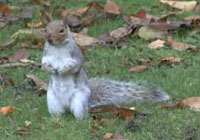Grey Squirrel Damage – a video presentation with Julian Evans

Down in his wood Julian is angry with the squirrels. In Part 2 of his video series, "Walking in the Woods" Professor Julian Evans shows the sort of damage they can do.
Lots more discussions, demos and tips at http://www.woodlandstv.co.uk/
Comments are closed for this post.
Discussion
Dear Julian,
I have just sent you a message asking for some assistance. It is to do with a possible project in Liberia with which I might be concerned in the near future. It is particulary concerned with community forestry. I sent you a short message but it came back from what is obviously a wrong email address. Most grateful if you could let me know your uptodate email address. Please note mine at the top. I may also be retaining the old onevwhich was [email protected]
My job would be education and training help the the Foresteri Training Institute in revisintg their curriculum and preparation of information for various groups concerning community forestery, conservation as well as commerce.
Hope to hear from you shortly.
David Gooday
[…] Deer could be described as ‘invasive species’ – a term that has more often been applied to plant species such as Rhododendron ponticum; this is rampant in some parts of the U.K. However, as Rackham says “the ground vegetation of ancient woods has been relatively resistant to invasive aliens”. Nevertheless, some anxiety has arisen with respect to the native bluebell and its spanish counterpart. The grey squirrel is also an ‘introduced’ species and considered an invasive species by some given the damage to young trees. […]
I enjoyed watching this Video so have posted a link to it on the new ‘Red Squirrel Forum’.
Cheers,
Dick
Some animal is digging up my bulbs and stripping bark from my trees. I think it is a squirrel but because I never see them I’m not sure. Can you describe the feces of a squirrel because I’ve found some every morning on my step. I live in a trailer park. Hope you can help me.
Thank you
I had squirels destroying my property by tearing it up for nesting material. I did everything I could to humanly discourage them.
We had similar problems two years ago when in not much more than a week a group of six 20 year old Oak trees were ring barked on the trunks with virtually all the bark removed from around 6 foot above the ground up to about 15 foot. This similar damage then occoured to all Oaks in the wood throuout the summer. Fresh damage was still being found into October which was much later than the squirells were expected to be ‘at it’. Less servere damage was noted on Hornbeam and Chestnut but only in patches, with no complete ring barking.
This reluctantly led to trapping which thinned out the population by 17 the next year when the only damage noted was greatly reduced and that mainly on Birch which had previously been untouched. This year the trapping will continue, to keep the numbers down and hopefully any bark damage will be minimal.
I commend professor Evans for his upfront illustration of Grey Squirrel damage. I think too many recent woodland owners put their heads in the leaf mould on this issue. They do look cute and cuddly, but the simple fact is they do not belong in UK woodland. As a lifelong conservationist, I find it difficult to kill any living creature, but unless you want to see 15 years of planning, management and tree growth wiped out in a single week, or your nestboxes raided, you had best start deterring these creatures from your patch. Be aware, just as you’ve thinned the weak and bent to leave your prime oak and cherry reaching for the skies as strong and sturdy specimens, along comes Mr Grey with his ring barking teeth.

Grey squirrels are affecting both red squirrels and birds. There is a possibility of them affecting dormice as well, but no one is sure on this.
While red squirrels eat eggs, grey squirrels, with their higher population densities and higher food requirements, require nearly 10 times as much food per acre than reds. Greys are much more destructive in every respect.
While occurences of serious ring barking by squirrels are uncommon, when it does happen it usually happens very badly.
Grey squirrels simply shouldn’t be here. They do not belong in our countryside because they are too destructive. A non native invasive species is never a good thing.
Reece
3 July, 2012